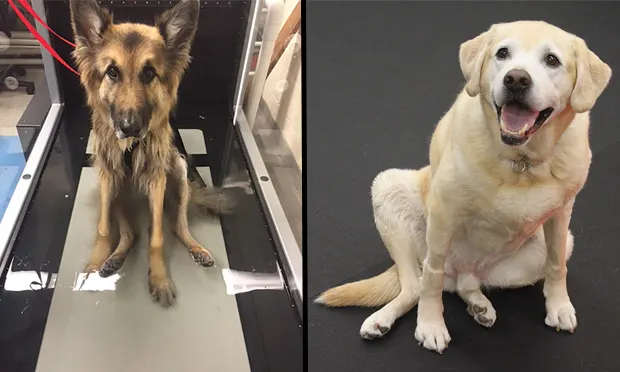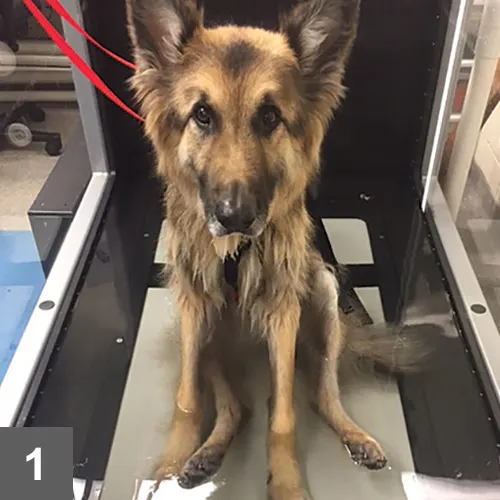Top 5 Most Common Orthopedic Conditions in Dogs
Mary Ellen Goldberg, BS, LVT, CVT, SRA, CCRA, Canine Rehabilitation Institute, Boynton Beach, Florida

Researchers who conducted a large study of purebred and crossbreed dogs with inherited conditions diagnosed over a 15-year period found that the following 5 orthopedic conditions occur most commonly1:
1. Elbow Dysplasia
This condition, seen most often in purebred dogs,1 encompasses multiple developmental anomalies of the cubital joint, including elbow incongruity, a fragmented medial coronoid process, an ununited anconeal process, osteochondrosis of the humeral condyle, and an ununited medial epicondyle.2

Bear, a German shepherd dog, has hip dysplasia, lumbosacral disease, and bilateral Supraspinatus tendinopathy.
2. Hip Dysplasia
This condition involves an abnormal hip socket formation that, in its severe form, may cause crippling lameness and painful joint arthritis (See Figure 1).3 Dogs may avoid strenuous exercise or be sore following such activity. Stiffness is often worse in the morning. Dogs developing hip dysplasia will consistently find it difficult to navigate stairs and rise from sitting or prone positions. A distinct clicking sound may occasionally be heard when the dog is walking or running.
3. Intervertebral Disc Degeneration
Seen mostly in purebred dogs,1 intervertebral disc degeneration is defined as a structural failure of the intervertebral disc associated with abnormal or accelerated changes seen in aging.4
4. Patellar Luxation
Defined as the lateral or medial displacement of the patella from the distal femur’s trochlear groove, patellar luxation comes in medial and lateral forms and is seen in dogs of all sizes. Medial patellar luxation in toy or small breeds is the most common presentation, whereas lateral luxation is seen more often in large breeds.5
5. Ruptured Cranial Cruciate Ligaments
Most commonly seen in crossbreed dogs,1 midsubstance rupture of the cranial cruciate ligaments (CCLs) develops from progressive pathologic fatigue, often under conditions of normal loading in adult dogs.6 Diagnosis is usually straightforward because most dogs have an obvious cranial drawer in the affected stifle joint. Patients with cruciate disease often show a chronic, intermittent, low-grade hindlimb lameness that responds to rest but recurs when exercise is reintroduced.7
More Findings
The same study1 found that 4 of the top 5 breeds affected with elbow dysplasia, by percentage, came from the mastiff-like dog lineage8: the Bernese mountain dog, Newfoundland, mastiff, and rottweiler.
CCL rupture and osteoarthritis are the 2 conditions that physical rehabilitation can most influence, according to evidence-based research.9
Orthopedic disease also affects other canine groups, including juvenile or immature animals10,11 and geriatric12,13 and sporting dogs.14,15
5 Most Common Breeds with Orthopedic Conditions
The following veterinary rehabilitation professionals, including the author, who are all members of the committee working toward the formation of the proposed Academy of Physical Rehabilitation Veterinary Technicians (APRVT), were asked to participate in a brief, informal survey about the 5 most common breeds seen with orthopedic disease. Following are their responses:
Julia Tomlinson, BVSc, MS, PhD, DACVS, CCRP, CVSMT, DACVSMR
Newfoundland
Saint Bernard
Rottweiler
Labrador retriever
German shepherd dog
Dawn Hickey, LVMT, CCRP
Great Dane
Doberman pinscher
Golden retriever
Labrador retriever
German shepherd dog
Jenn Panko, RVT/CCRP (OCMC, CAPMC)
Rottweiler
Labrador retriever
Newfoundland
German shepherd dog
Golden retriever
Kristen L. Hagler, BS (An. Phys.), RVT, CCRP, CVPP, COCM, CBW
Labrador retriever
Golden retriever
Rottweiler
Bernese mountain dog
Border collie
(Author) Mary Ellen Goldberg, BS, LVT, CVT, SRA, CCRA
Great Dane
Rottweiler
Saint Bernard
German shepherd dog
Labrador retriever
Veterinary Technician Role
The goal of a veterinary rehabilitation practice is to improve the patient’s quality of life so he or she can perform daily living activities more comfortably. The rehabilitation veterinary technician will be the first to see the patient and client in the examination room, where he or she should:
Put the patient and client at ease before taking a detailed history
Explain the at-home and in-practice therapy program to the client so that it is easy to understand
Assist in handling the patient to take measurements and record observations (eg, vital signs, pain scoring)
Participate in the therapies prescribed by the rehabilitation veterinarian.
Rehabilitation Therapy
The rehabilitation veterinarian likely will prescribe therapeutic exercises to increase active range of motion (ROM), strength, endurance, speed, and proprioception.16 The veterinary technician usually directs the exercises, which are designed to restore the function of injured and dysfunctional limbs, beginning with low-level activities and progressing to higher level activities.16
The veterinary technician may also perform many physical agent modalities, which are useful adjuncts to medical and surgical interventions, exercise, and manual therapy.17 Orthopedic conditions also may benefit from thermal modalities, transcutaneous electrical nerve stimulation, ultrasound and laser therapy, and extracorporeal shock wave therapy.18 Patients must be given appropriate analgesic therapy before undergoing physical rehabilitation.
Common Signs in Young Service Dogs
Kristen L. Hagler, one of the veterinary technicians surveyed (see 5 Most Common Breeds with Orthopedic Conditions, above) noted the following signs in dogs 14 to 18 months of age that were training for service:
Asymmetrical sitting posture (see Figure 2)
Aversion to jumping (because of pain in the stifles & spine)
Balking when getting into a down position (elbows)
Balking when getting into vehicles (stifles, spine)
Hesitation to sit or stay in the sphinx position (spine, stifles, hock, hips)
Poor gait (eg, ambling or pacing)
Slow walking.

A dog exhibits an asymmetrical sitting posture.
Dogs training for service are commonly breeds susceptible to orthopedic conditions and are watched for early signs of inheritable diseases and musculoskeletal disorders. The signs listed are often associated with job-specific tasks and generally seen when the dogs have been in training for only a few weeks and are not yet well-conditioned.
Conclusion
The veterinary rehabilitation technician often plays a primary role in aiding the rehabilitation veterinarian in caring for patients with orthopedic disease, which usually affects larger-breed dogs.
The veterinarian and veterinary technician should act as a team, using their complementary skills and clear communication, which are vital to the patient’s progress.
This article originally appeared in the August 2015 issue of Veterinary Team Brief.